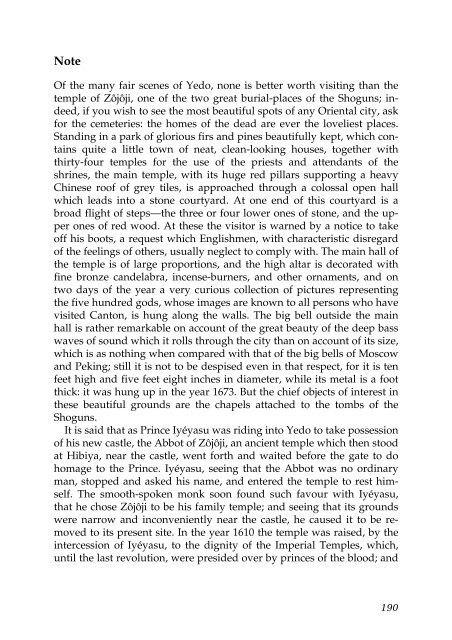You also want an ePaper? Increase the reach of your titles
YUMPU automatically turns print PDFs into web optimized ePapers that Google loves.
Note<br />
Of the many fair scenes <strong>of</strong> Yedo, none is better worth visiting than the<br />
temple <strong>of</strong> Zôjôji, one <strong>of</strong> the two great burial-places <strong>of</strong> the Shoguns; indeed,<br />
if you wish to see the most beautiful spots <strong>of</strong> any Oriental city, ask<br />
for the cemeteries: the homes <strong>of</strong> the dead are ever the loveliest places.<br />
Standing in a park <strong>of</strong> glorious firs and pines beautifully kept, which contains<br />
quite a little town <strong>of</strong> neat, clean-looking houses, together with<br />
thirty-four temples for the use <strong>of</strong> the priests and attendants <strong>of</strong> the<br />
shrines, the main temple, with its huge red pillars supporting a heavy<br />
Chinese ro<strong>of</strong> <strong>of</strong> grey tiles, is approached through a colossal open hall<br />
which leads into a stone courtyard. At one end <strong>of</strong> this courtyard is a<br />
broad flight <strong>of</strong> steps—the three or four lower ones <strong>of</strong> stone, and the upper<br />
ones <strong>of</strong> red wood. At these the visitor is warned by a notice to take<br />
<strong>of</strong>f his boots, a request which Englishmen, with characteristic disregard<br />
<strong>of</strong> the feelings <strong>of</strong> others, usually neglect to comply with. The main hall <strong>of</strong><br />
the temple is <strong>of</strong> large proportions, and the high altar is decorated with<br />
fine bronze candelabra, incense-burners, and other ornaments, and on<br />
two days <strong>of</strong> the year a very curious collection <strong>of</strong> pictures representing<br />
the five hundred gods, whose images are known to all persons who have<br />
visited Canton, is hung along the walls. The big bell outside the main<br />
hall is rather remarkable on account <strong>of</strong> the great beauty <strong>of</strong> the deep bass<br />
waves <strong>of</strong> sound which it rolls through the city than on account <strong>of</strong> its size,<br />
which is as nothing when compared with that <strong>of</strong> the big bells <strong>of</strong> Moscow<br />
and Peking; still it is not to be despised even in that respect, for it is ten<br />
feet high and five feet eight inches in diameter, while its metal is a foot<br />
thick: it was hung up in the year 1673. But the chief objects <strong>of</strong> interest in<br />
these beautiful grounds are the chapels attached to the tombs <strong>of</strong> the<br />
Shoguns.<br />
<strong>It</strong> is said that as Prince Iyéyasu was riding into Yedo to take possession<br />
<strong>of</strong> his new castle, the Abbot <strong>of</strong> Zôjôji, an ancient temple which then stood<br />
at Hibiya, near the castle, went forth and waited before the gate to do<br />
homage to the Prince. Iyéyasu, seeing that the Abbot was no ordinary<br />
man, stopped and asked his name, and entered the temple to rest himself.<br />
The smooth-spoken monk soon found such favour with Iyéyasu,<br />
that he chose Zôjôji to be his family temple; and seeing that its grounds<br />
were narrow and inconveniently near the castle, he caused it to be removed<br />
to its present site. In the year 1610 the temple was raised, by the<br />
intercession <strong>of</strong> Iyéyasu, to the dignity <strong>of</strong> the Imperial Temples, which,<br />
until the last revolution, were presided over by princes <strong>of</strong> the blood; and<br />
190



